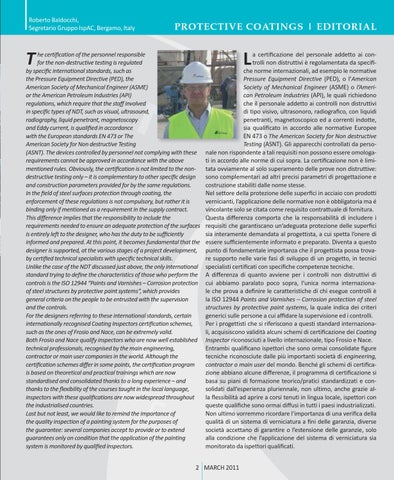Roberto Baldocchi, Segretario Gruppo IspAC, Bergamo, Italy
Zaniolo CdA - 03.11
T
PROTECTIVE COATINGS
he certification of the personnel responsible for the non-destructive testing is regulated by specific international standards, such as the Pressure Equipment Directive (PED), the American Society of Mechanical Engineer (ASME) or the American Petroleum Industries (API) regulations, which require that the staff involved in specific types of NDT, such as visual, ultrasound, radiography, liquid penetrant, magnetoscopy and Eddy current, is qualified in accordance with the European standards EN 473 or The American Society for Non destructive Testing (ASNT). The devices controlled by personnel not complying with these requirements cannot be approved in accordance with the above mentioned rules. Obviously, the certification is not limited to the nondestructive testing only – it is complementary to other specific design and construction parameters provided for by the same regulations. In the field of steel surfaces protection through coating, the enforcement of these regulations is not compulsory, but rather it is binding only if mentioned as a requirement in the supply contract. This difference implies that the responsibility to include the requirements needed to ensure an adequate protection of the surfaces is entirely left to the designer, who has the duty to be sufficiently informed and prepared. At this point, it becomes fundamental that the designer is supported, at the various stages of a project development, by certified technical specialists with specific technical skills. Unlike the case of the NDT discussed just above, the only international standard trying to define the characteristics of those who perform the controls is the ISO 12944 “Paints and Varnishes – Corrosion protection of steel structures by protective paint systems”, which provides general criteria on the people to be entrusted with the supervision and the controls. For the designers referring to these international standards, certain internationally recognised Coating Inspectors certification schemes, such as the ones of Frosio and Nace, can be extremely valid. Both Frosio and Nace qualify inspectors who are now well established technical professionals, recognised by the main engineering, contractor or main user companies in the world. Although the certification schemes differ in some points, the certification program is based on theoretical and practical trainings which are now standardised and consolidated thanks to a long experience – and thanks to the flexibility of the courses taught in the local language, inspectors with these qualifications are now widespread throughout the industrialised countries. Last but not least, we would like to remind the importance of the quality inspection of a painting system for the purposes of the guarantee: several companies accept to provide or to extend guarantees only on condition that the application of the painting system is monitored by qualified inspectors.
L
EDITORIAL
a certificazione del personale addetto ai controlli non distruttivi è regolamentata da specifiche norme internazionali, ad esempio le normative Pressure Equipment Directive (PED), o l’American Society of Mechanical Engineer (ASME) o l’American Petroleum Industries (API), le quali richiedono che il personale addetto ai controlli non distruttivi di tipo visivo, ultrasonoro, radiografico, con liquidi penetranti, magnetoscopico ed a correnti indotte, sia qualificato in accordo alle normative Europee EN 473 o The American Society for Non destructive Testing (ASNT). Gli apparecchi controllati da personale non rispondente a tali requisiti non possono essere omologati in accordo alle norme di cui sopra. La certificazione non è limitata ovviamente al solo superamento delle prove non distruttive: sono complementari ad altri precisi parametri di progettazione e costruzione stabiliti dalle nome stesse. Nel settore della protezione delle superfici in acciaio con prodotti vernicianti, l’applicazione delle normative non è obbligatoria ma é vincolante solo se citata come requisito contrattuale di fornitura. Questa differenza comporta che la responsabilità di includere i requisiti che garantiscano un’adeguata protezione delle superfici sia interamente demandata al progettista, a cui spetta l’onere di essere sufficientemente informato e preparato. Diventa a questo punto di fondamentale importanza che il progettista possa trovare supporto nelle varie fasi di sviluppo di un progetto, in tecnici specialisti certificati con specifiche competenze tecniche. A differenza di quanto avviene per i controlli non distruttivi di cui abbiamo paralato poco sopra, l’unica norma internazionale che prova a definire le caratteristiche di chi esegue controlli è la ISO 12944 Paints and Varnishes – Corrosion protection of steel structures by protective paint systems, la quale indica dei criteri generici sulle persone a cui affidare la supervisione ed i controlli. Per i progettisti che si riferiscono a questi standard internazionali, acquisiscono validità alcuni schemi di certificazione dei Coating Inspector riconosciuti a livello internazionale, tipo Frosio e Nace. Entrambi qualificano ispettori che sono ormai consolidate figure tecniche riconosciute dalle più importanti società di engineering, contractor o main user del mondo. Benché gli schemi di certificazione abbiano alcune differenze, il programma di certificazione si basa su piani di formazione teorico/pratici standardizzati e consolidati dall’esperienza pluriennale, non ultimo, anche grazie alla flessibilità ad aprire a corsi tenuti in lingua locale, ispettori con queste qualifiche sono ormai diffusi in tutti i paesi industrializzati. Non ultimo vorremmo ricordare l’importanza di una verifica della qualità di un sistema di verniciatura a fini delle garanzia, diverse società accettano di garantire o l’estensione delle garanzie, solo alla condizione che l’applicazione del sistema di verniciatura sia monitorato da ispettori qualificati.
1 MARCH 2 JANUARY2011 2011
